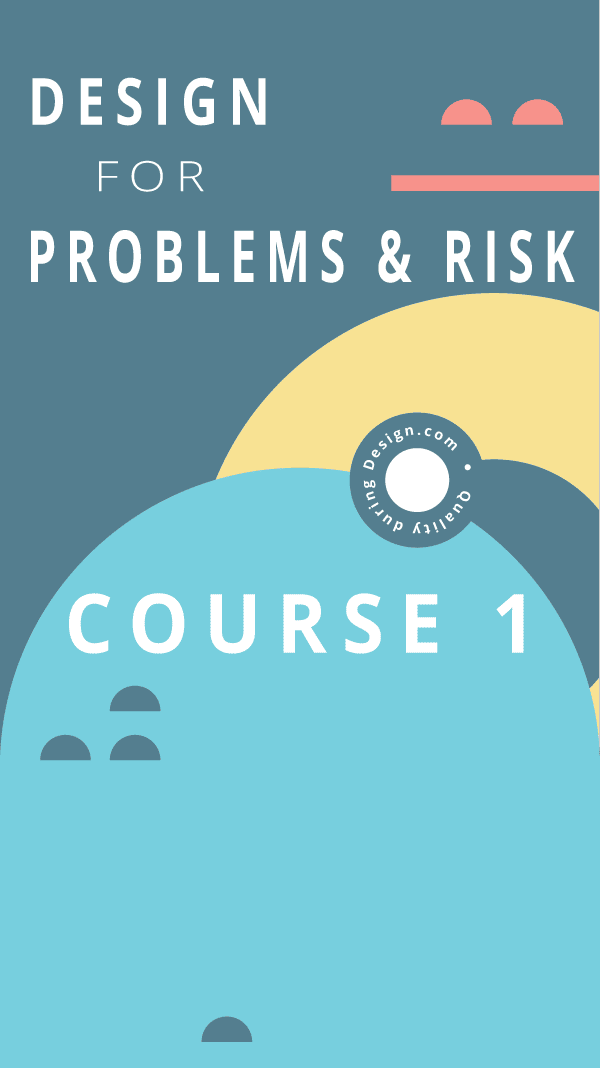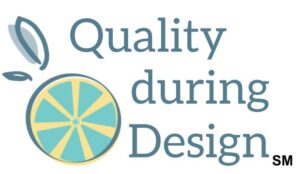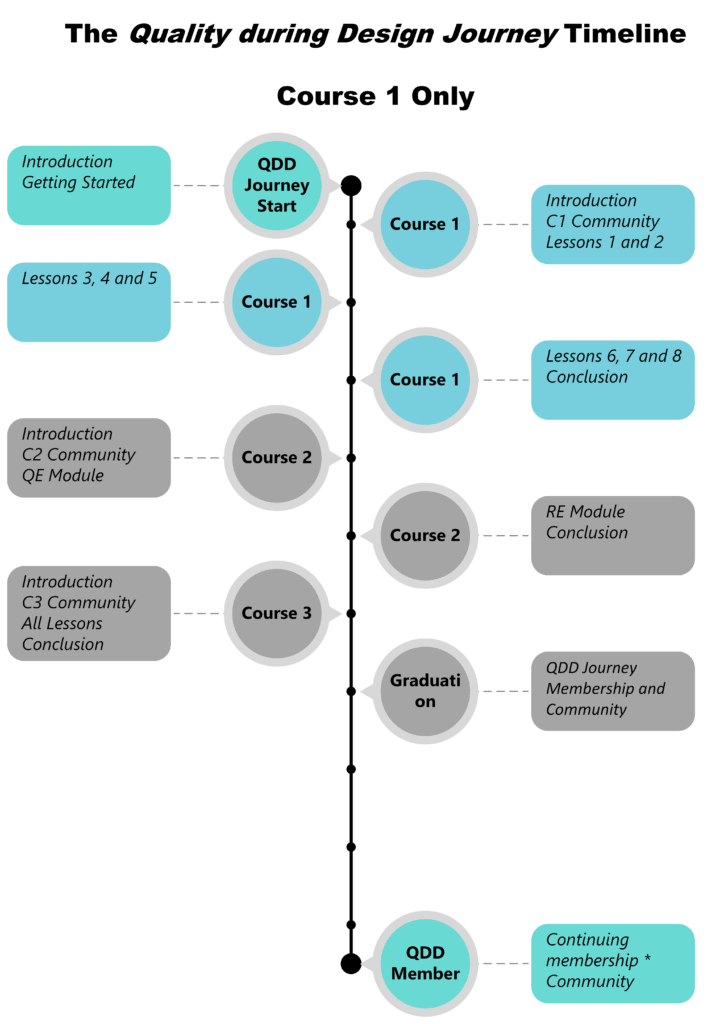
Course 1: Design for Problems and Risk
About Course 1: Design for Problems and Risk
Welcome to Course 1 of the QDD Journey, [accessally_user_firstname]!
Course 1 is titled "Design for Problems and Risk".
You'll be learning about ways to think about and develop design concepts with your team based on...well, problems and risk.
Let's set up for success! This ABOUT page shows you what we'll be covering. It also shows you how to navigate course material and where to access information related to the course.
What you'll learn
Learning objectives
The learning objectives are integrated throughout this course using the materials within this online portal and the practice problems.
Download and view the course syllabus and the tables that relate learning objectives and course activities. You'll gain an understanding of the Course 1 Journey and how to get the most out of this course.
Relationship between learning objectives and course activities
Additionally, all of the upcoming lessons and their recommended week to consume are listed and linked at the bottom of this page for your information and as another navigation option.
Learner Prerequisites
This course is created for learners involved in product design development. An engineering degree or background is useful but is not a prerequisite to this course.
Topics
We'll be covering topics in these four areas: root causes, risks, concept development, and field monitoring. There are 3 main areas of design engineering where we'll be applying these topics:
- adjust design activities to add solving problems and controlling risks
- define problems and know when we have the root cause
- use frameworks for (you and your) teams to explore, prioritize, and iterate on the product design.
[progressally_progress_pie_chart post_id="11714" size="80"]
Course 1: Design for Problems and Risk
Lessons
Lessons will automatically be marked complete when you've completed all of the objectives in that lesson.
[progressally_objectives layout="hide|end-of-line"]
Upcoming Course Modules & Lessons
Recommended Pace over 3 weeks
Introduction
Immediate Access
[accessally_icon post_id="11715"]
Introduction: Quality during Design Mindset
Designing for excellence includes reaching out for collaboration and coming at design from multiple viewpoints. There are some ideas about design engineering that limit these other approaches.
We review these ideas and turn them on their head, so we're set-up for success with Quality during Design.
QDD Journey Discussion Group
This is the place to ask questions and get answers.
Module 1: Clarity from Problems
Week 1
[accessally_icon post_id="11679"]
Lesson 1: Causal Chain and Root Causes
If we can define the problem, we almost have the solution.
We introduce a symptom-problem-cause model that we'll be using throughout the rest of this course. We also talk about root causes and variations of diagrams that we can use with our cross-functional team to prompt some discussion and decision making.
[accessally_icon post_id="11717"]
Lesson 2: Symptom Break-Down to Assess Risk
There's more to symptoms that we might originally think. We talk about how to break them down into their smaller parts to help teams understand potential outcomes and impacts so we can get started with strong design inputs.
We introduce a risk analysis based on symptoms. This lets us start to assess the risk of a design concept, so we can start prioritizing features and requirements of what is yet to be designed.
Module 2: Design for Risks
Week 2
[accessally_icon post_id="11718"]
Lesson 3: Design as Controls
We re-frame design inputs and outputs as controls, considering the design of the whole system. We also classify controls as prevention and detection.
[accessally_icon post_id="11737"]
Lesson 4: FMEA in Product Development
We introduce FMEA for you to be able to be an active contributor this powerful analysis. We also start to populate it with our symptom-problem-cause model and our symptom break-out model, from the previous lessons.
[accessally_icon post_id="11720"]
Lesson 5: Risk Rating Criteria
We take FMEA a step further with rating and prioritization. We focus on using the ratings in the FMEA to rank risks and propose controls and actions to address risk. We can help guide others in deciding about a risk rating.
Module 3: Iterating on the Design
Week 3
[accessally_icon post_id="11721"]
Lesson 6: Building Risk Analyses for Design Decisions
We explore all the types of FMEAs plus Hazards Analysis, how we decide which ones to do depending on what we want to learn and analyze. This lesson brings together all the previous lesson into FMEA mastery!
[accessally_icon post_id="11722"]
Lesson 7: Iterating through the Development Process
We talk about the product development process, that FMEAs and other risk analyses are "living documents", and how to iterate on the design and the risk analyses to build upon our knowledge base to design with success.
[accessally_icon post_id="11723"]
Lesson 8: Monitoring after Launch
We have a responsibility to monitor our product after launch, to both look for opportunities and to check that our product is being used in the use environment that we intended at the start of our design.





